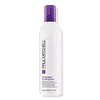What's inside
What's inside
 Key Ingredients
Key Ingredients

No key ingredients
 Benefits
Benefits

No benefits
 Concerns
Concerns

 Ingredients Side-by-side
Ingredients Side-by-side

Water
Skin ConditioningIsobutane
Vp/Va Copolymer
Hedychium Coronarium Root Extract
MaskingPEG-12 Dimethicone
Skin ConditioningBisamino PEG/PPG-41/3 Aminoethyl Pg-Propyl Dimethicone
Steareth-21
CleansingPolyquaternium-11
Cocamidopropyl Betaine
CleansingCocamidopropyl Hydroxysultaine
CleansingDiazolidinyl Urea
PreservativePPG-5-Ceteth-20
EmulsifyingCaprylyl Glycol
EmollientPhenoxyethanol
PreservativePentaerythrityl Tetracaprylate/Tetracaprate
EmollientPropane
Sodium Chloride
MaskingLaurtrimonium Chloride
EmulsifyingSodium Bisulfite
AntioxidantParfum
MaskingHexyl Cinnamal
PerfumingHydroxycitronellal
PerfumingLimonene
PerfumingWater, Isobutane, Vp/Va Copolymer, Hedychium Coronarium Root Extract, PEG-12 Dimethicone, Bisamino PEG/PPG-41/3 Aminoethyl Pg-Propyl Dimethicone, Steareth-21, Polyquaternium-11, Cocamidopropyl Betaine, Cocamidopropyl Hydroxysultaine, Diazolidinyl Urea, PPG-5-Ceteth-20, Caprylyl Glycol, Phenoxyethanol, Pentaerythrityl Tetracaprylate/Tetracaprate, Propane, Sodium Chloride, Laurtrimonium Chloride, Sodium Bisulfite, Parfum, Hexyl Cinnamal, Hydroxycitronellal, Limonene
Water
Skin ConditioningCetyl Alcohol
EmollientDidecyldimonium Chloride
EmulsifyingPolyquaternium-37
Panthenol
Skin ConditioningHedychium Coronarium Flower/Leaf/Stem Extract
Skin ConditioningRosmarinus Officinalis Leaf Extract
AntimicrobialAnthemis Nobilis Flower Extract
MaskingAloe Barbadensis Leaf Extract
EmollientSimmondsia Chinensis Leaf Extract
HumectantAlgae Extract
EmollientWheat Amino Acids
Skin ConditioningHydrolyzed Wheat Protein
Skin ConditioningHydrolyzed Wheat Starch
Skin ConditioningHydrolyzed Wheat Protein Pg-Propyl Silanetriol
Skin ConditioningCocodimonium Hydroxypropyl Hydrolyzed Rice Protein
Skin ConditioningCetrimonium Chloride
AntimicrobialIsopropyl Alcohol
SolventPropylene Glycol Dicaprylate/Dicaprate
EmollientPPG-1 Trideceth-6
Skin ConditioningMagnesium Nitrate
Bisamino PEG/PPG-41/3 Aminoethyl Pg-Propyl Dimethicone
Methylchloroisothiazolinone
PreservativeMagnesium Chloride
Potassium Sorbate
PreservativePhenoxyethanol
PreservativePEG-12 Dimethicone
Skin ConditioningMethylisothiazolinone
PreservativeParfum
MaskingBenzyl Benzoate
AntimicrobialBenzyl Alcohol
PerfumingSodium Benzoate
MaskingWater, Cetyl Alcohol, Didecyldimonium Chloride, Polyquaternium-37, Panthenol, Hedychium Coronarium Flower/Leaf/Stem Extract, Rosmarinus Officinalis Leaf Extract, Anthemis Nobilis Flower Extract, Aloe Barbadensis Leaf Extract, Simmondsia Chinensis Leaf Extract, Algae Extract, Wheat Amino Acids, Hydrolyzed Wheat Protein, Hydrolyzed Wheat Starch, Hydrolyzed Wheat Protein Pg-Propyl Silanetriol, Cocodimonium Hydroxypropyl Hydrolyzed Rice Protein, Cetrimonium Chloride, Isopropyl Alcohol, Propylene Glycol Dicaprylate/Dicaprate, PPG-1 Trideceth-6, Magnesium Nitrate, Bisamino PEG/PPG-41/3 Aminoethyl Pg-Propyl Dimethicone, Methylchloroisothiazolinone, Magnesium Chloride, Potassium Sorbate, Phenoxyethanol, PEG-12 Dimethicone, Methylisothiazolinone, Parfum, Benzyl Benzoate, Benzyl Alcohol, Sodium Benzoate
Ingredients Explained
These ingredients are found in both products.
Ingredients higher up in an ingredient list are typically present in a larger amount.
Bisamino PEG/PPG-41/3 Aminoethyl Pg-Propyl Dimethicone is a type of silicone.
Parfum is a catch-all term for an ingredient or more that is used to give a scent to products.
Also called "fragrance", this ingredient can be a blend of hundreds of chemicals or plant oils. This means every product with "fragrance" or "parfum" in the ingredients list is a different mixture.
For instance, Habanolide is a proprietary trade name for a specific aroma chemical. When used as a fragrance ingredient in cosmetics, most aroma chemicals fall under the broad labeling category of “FRAGRANCE” or “PARFUM” according to EU and US regulations.
The term 'parfum' or 'fragrance' is not regulated in many countries. In many cases, it is up to the brand to define this term.
For instance, many brands choose to label themselves as "fragrance-free" because they are not using synthetic fragrances. However, their products may still contain ingredients such as essential oils that are considered a fragrance by INCI standards.
One example is Calendula flower extract. Calendula is an essential oil that still imparts a scent or 'fragrance'.
Depending on the blend, the ingredients in the mixture can cause allergies and sensitivities on the skin. Some ingredients that are known EU allergens include linalool and citronellol.
Parfum can also be used to mask or cover an unpleasant scent.
The bottom line is: not all fragrances/parfum/ingredients are created equally. If you are worried about fragrances, we recommend taking a closer look at an ingredient. And of course, we always recommend speaking with a professional.
Learn more about ParfumPEG-12 Dimethicone is a type of water-soluble silicone. It has skin conditioning and hydrating properties.
According to a manufacturer, this ingredient's stability is decreased by strong acid or alkali.
Phenoxyethanol is a preservative that has germicide, antimicrobial, and aromatic properties. Studies show that phenoxyethanol can prevent microbial growth. By itself, it has a scent that is similar to that of a rose.
It's often used in formulations along with Caprylyl Glycol to preserve the shelf life of products.
Water. It's the most common cosmetic ingredient of all. You'll usually see it at the top of ingredient lists, meaning that it makes up the largest part of the product.
So why is it so popular? Water most often acts as a solvent - this means that it helps dissolve other ingredients into the formulation.
You'll also recognize water as that liquid we all need to stay alive. If you see this, drink a glass of water. Stay hydrated!
Learn more about Water